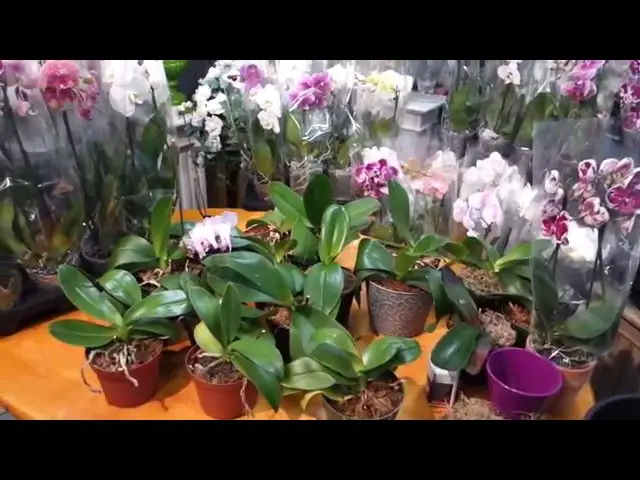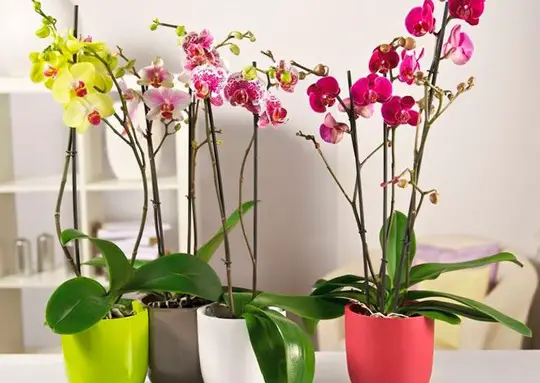How Can I Get My Orchid to Bloom Again
Phalaenopsis is one of the virtually flexible orchids, capable of blooming nearly uninterruptedly. However, novice orchid growers often observe long pauses betwixt flowering of this orchid. The proposed article will tell yous about How practice you lot get an orchid to bloom over again and why this happens.

How practice you go an orchid to bloom again?
if you want to flower orchid again you lot need to take care of miskate during orchid flowering. hither complete stride by step guide on blooming your orchid again.
How exercise you lot intendance for a blooming orchid?
Despite their adjustability to any conditions of detention, phalaenopsis, similar other plants, begin to release flower arrows but under sure conditions:
- Long daylight hours and intense sun exposure.In ordinary Russian apartments, where plants chronically lack sunlight for half dozen months, this condition is not provided. Normal daylight hours for orchids are 12 hours. Therefore, starting in autumn, the missing hours of natural light must be filled with artificial.
- Daily drops in air temperature.Phalaenopsis are thermophilic orchids, but they bloom just with fluctuations in twenty-four hours and night temperatures. It should be warm during the day and absurd at night, and the temperature difference is desirable inside 5-8 degrees.
- Alter of "seasons of humidity".In tropical forests, where orchids of this species grow in nature, the modify of the rainy and drought seasons is very pronounced. Hybrid phalaenopsis are ameliorate adapted to the absence of such a change, but even so blossom better after temporary drying.
Cheque it out Why Are My Orchid Buds Falling Off?
Among the accompanying conditions for the normal flowering of phalaenopsis, one can name the age of the establish and the country of its wellness. It is understood that an orchid suffering from infections or pests, undergoing pesticide treatments, can take long breaks between blooms.
Important! Phalaenopsis, like other orchids, have a dormant stage, only unremarkably information technology is poorly expressed in them. Therefore, y'all do not need to look abiding flowering from the found. At that place are different phases in the life cycle of phalaenopsis, and a short break in flowering is necessary for them to build up roots and leaves.
A healthy phalaenopsis that does not blossom, simply cheerfully grows roots and young leaves, does not need to stimulate flowering. At the stop of the growth phase, the orchid will independently release a peduncle. The primary affair is to maintain good conditions of detention.
Mistakes leading to inhibition of Orchid flowering
The long absence of flowering in phalaenopsis orchids is often caused by mistakes made by bloom growers:
- Frequent and abundant feeding.Orchids should not be over-fed, specially with nitrogen-containing fertilizers. The nutritional requirements of these plants are much lower than that of any others.
- Failure to maintain a balance between humidity, air temperature and illumination.These three conditions must be clearly regulated. At a loftier temperature, there may be more light and moisture; in a cool apartment, watering and spraying should be rare, but the corporeality of light should be sufficient.
- Stimulant abuse.Even healthy vitamin supplements should be applied in moderation. Moreover, this applies to hormonal drugs, which in case of overdoses cause the opposite effect – not stimulation of growth and flowering, merely oppression.
Blooming is also inhibited by such circumstances as the frequent change of the location of the orchid in the apartment, transplantation or treatment with potent systemic pesticides.
Stimulation of the formation of a peduncle in phalaenopsis
The lack of flowering in phalaenopsis tin exist expressed in unlike means. The most common manifestation is the stubborn refusal of a plant to release a peduncle. At the same time, phalaenopsis tin feel peachy, regularly requite new leaves, co-operative out the root system. This is normal for 1-3 months, simply sometimes this situation drags on for a year or more than.
If the phalaenopsis does not release the arrow for a long time, you tin force it to change the phase of the life cycle as follows:
- Artificial drought.At get-go, watering is gradually reduced to the orchid throughout the month. During this period, bathing in the shower stops, the pot is immersed in water, irrigation becomes rare and only through a watering tin along the border of the pot. Afterwards a month, watering and spraying completely stop. The dry out period tin can be maintained from 3 weeks to a month.
- Decrease in temperature.This measure enhances the effect of artificial drought. For the duration of the drying catamenia, the orchid is placed in cooler conditions than usual, and after the end of the dry menstruation, it returns to its identify.
Such stimulation is called "stressful" and is successfully practiced by many growers:
"In general, my phalaenopsis blooms regularly. Simply there was i stubborn person who, after the end of the store bloom, sat idle for a whole year. She felt pitiful for him for a long time, merely in the leap she decided to give him stress. I dried the soil, sent it to the glassed-in balcony, and left it at that place without water for almost a month. During the day, the temperature there was normal, nigh +25, but at night information technology dropped to +10. In that location is a lot of light. When the leaves began to wrinkle slightly, she returned the exile dwelling, watered him with immersion, and fed him. The arrow hatched in 2 weeks".
With the beginning of the growth of the peduncle, irrigation must be performed regularly. At this stage, prolonged drying of the substrate should not be allowed, but it is also not recommended to fill it. The soil should saturate the roots with water and dry out in a few hours. The side by side watering is 2-3 days after the whitening of the velamen layer.
Recommended for you When To Transplant Phalaenopsis Orchids?
What to do when orchids take stopped flowering?

Another option for inhibition of flowering is less common. It is expressed in the fact that the peduncle that began to course suddenly stops growing. In this case, the problem is solved differently:
- The humidity of the substrate and air is checked.Watering is normalized so that the orchid is well supplied with water, but the substrate does non remain wet for more than than a day. Air humidity rises to 60-70%.
- A phytolamp is installed above the orchid.In this instance, the main luminous flux is directed to the tip of the peduncle.
- Foliar summit dressing with boron fertilizer is performed.To exercise this, you can dilute boric acrid in water (i 1000 per 1 l) or apply a special complex fertilizer for orchids containing boron.
It is as well worth checking the air temperature. At this stage, daily drops should exist maintained, but likewise low dark temperatures are contraindicated.During the menses of peduncle growth, the optimal thermometer at night is +180 C.
A frozen, but lively peduncle should not dry. If its top is dry out, then flowering will not take place, and the arrow will have to be cut out.
Should you fertilize orchids when they are blooming?
Fertilizers play a secondary, just of import role in the regulation of orchid flowering. Sometimes phalaenopsis refuses to bloom if it is depleted, and and so the plant must be given i of the following fertilizers containing:
| Clarification | Application |
| Complete complex with good phosphorus and potassium content, enriched with boron, manganese, iron, zinc, copper, and molybdenum. | 5 ml of the drug is dissolved in 1 liter of h2o, watering is performed at the root. |
| The ready-to-use solution in the grade of a spray containing a complete set of nutrients, enriched with B vitamins and amino acids. | Spray the leaves and aeriform roots one time a week. |
| An innovative formula with a full complement of mineral elements in the form of salts and chelates, enriched with succinic acid, amino acids, and B vitamins. | For irrigation 1 ml of fertilizer is diluted per one liter of h2o. For spraying ane ml of fertilizer is diluted into 2 liters of water. |
For the start of flowering, an orchid needs a normal phosphorus supply.Therefore, during the growth of the peduncle, it is necessary to regularly utilise phosphorus-containing compositions.
Equally shortly every bit the phalaenopsis forms buds, feeding stops. Exercise shows that the utilize of fertilizers shortens the flowering flow.
Expert advice on How do you get an orchid to flower again?
When an orchid refuses to bloom, at that place is a groovy temptation to use some kind of hormonal stimulant, for instance, cytokinin paste. Simply it is meliorate to refrain from using such funds:
"There is no demand to smear the axillary buds of phalaenopsis with cytokinin. In about cases, the lack of flowering is associated with a lack of lite, and hormones in such conditions only exacerbate the situation. Good low-cal, correct temperature and moderate irrigation – and Phalaenopsis itself will bloom regularly and profusely."
Recommended for yous How To Propagate Cattleya Orchids?
how to become multiple stems on an orchid?
No mode. A plant is a living organism, and independently regulates the number of arrows that it tin grow. It is only necessary to provide the orchid with total care and suitable conditions, and there is no need to specifically interfere with the natural evolution process.
Here you accept learned that when and How practise you get an orchid to blossom once again indoor. Follow all steps discussed above.
Source: https://houseplantspro.com/get-an-orchid-to-bloom-again/